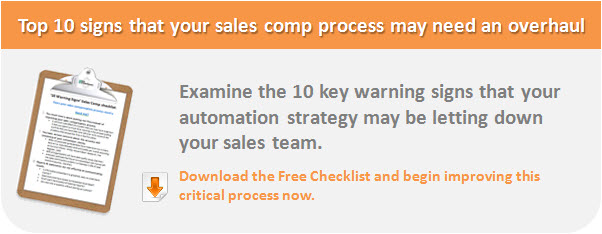We are often asked for guidance on SaaS sales compensation plans. My canned response has become that they are like any other sales comp plan; ‘simple, but damn hard to do well’.
What makes SaaS plans simple?
Much has been written by some very smart people about SaaS plan design. I personally found some posts by Joel York & Phillipe Botteri very insightful. Here are a few of the highpoints of the basics that are fairly easy to get your arms around:
-
Keep it as simple as possible: The primary principle of sales compensation is to pay the sales rep in proportion to the value of the revenue (deals) they drive.
-
The SaaS business model is based on a subscription based recurring revenue business model. The job of a SaaS sales rep is to grow the subscription volume over time. With this fundamental job description, the core performance measure of a sales rep selling SaaS products is Recurring Revenue and the key Performance Measure of a SaaS sales comp plan is the Life Time Value (LTV) of a SaaS contract.
-
As a proxy for LTV, SaaS plans commonly use the monthly recurring revenue (MRR), Quarterly Recurring Revenue (QRR) or Annual Recurring Revenue (ARR) as a metric closely related to LTV. Which one to use?
-
One approach is to base your SaaS sales compensation plan on a recurring revenue time-frame (monthly, quarterly, or annually) that equals your most common contract renewal term, e.g., if you mostly sign annual renewal contracts, then base your sales compensation plan on ARR (note that you can still pay monthly or quarterly against this measurement time frame).
-
Another approach is use the following Rule of thumb; performance & quota time period should closely mirror the sales cycle time.
-
-
Takeaway - if you replace unit sales with MRR/QRR or ARR, the plans are actually quite straight forward.
-
A few
 tips & Best Practice discussion;
tips & Best Practice discussion; -
Tip: Why are annual targets commonly preferred over monthly or quarterly targets? To avoid reps pushing deals from one quarter to the next, the quota can be set annually and the compensation plan can be built on annual targets instead of a quarterly targets.
-
Tip: If average deal size is small and sales cycle is short, move towards a monthly or quarterly recurring revenue target.
-
A quick rule of thumb is that one month of MRR for any given deal is roughly equal to your commission expense (works out to1/12 or 8.3% commission rate)
-
Pay on invoices, not bookings; Don’t be fooled by contract terms, longer term contracts may seem attractive, but the truth is that if you have an unsatisfied client who wants out of a contract, they will find a way to get out of that contract. If you want to encourage your sales team to close long term contracts offer a SPIFF or pay an accelerated rate on that deal in year two, but do so as years 2 & 3 of that deal kick in.
-
Do not pay on cash receipts; while this is attractive option for finance, your business should seriously consider if you want your sales reps focusing on growth and closing new business, or on reducing DSO. These are two completely different business objectives.
Why is it so hard to do a great job managing & administering SaaS plans ?
In a word; complexity. Complexity rears its head when your get deep into some of the business needs that often overlap with the comp plans. Here are a few of the instances where simple plans can become much more complex, in a hurry. We list them below and plan to discuss them in more depth in future Blogs, be sure to subscribe to the blog in the quick form on the right to can have updates e-mails directly to you.
-
If your business is just ramping up and you are unsure of the quota’s early on, are there ways to build a plan that still rewards the reps but limits exposure to a windfall situation?
-
Are you looking to encourage multi-year agreements? How should they be rewarded?
-
Should you segment sales roles to focus on either new sales (growth) or renewals & how should they get paid?
-
Should I segment sales roles by hunters (growth), farmers (renewals) or go with a hybrid design? How does this affect plan design?
-
How should you compensate reps as MRR at an existing account grow due to added seats?
-
Should you consider paying on cash receipt, booking or invoice?
-
Should I build a commission plan or one based on sales bonuses?
-
What about rewarding reps that negotiate a contract that is paid in full up front?
-
For companies who offer multiple product lines, is it possible to stagger commission rates across the various product lines ?
-
How should reps be compensated so they pay close attention to account churn.
There are many variables here that provide the sales executive with the ability to tweak plans as the year goes on to adjust to the market. It also places an emphasis on thinking ahead and putting in place infrastructure to enable you to manage these plans in a flexible and scalable manner.






